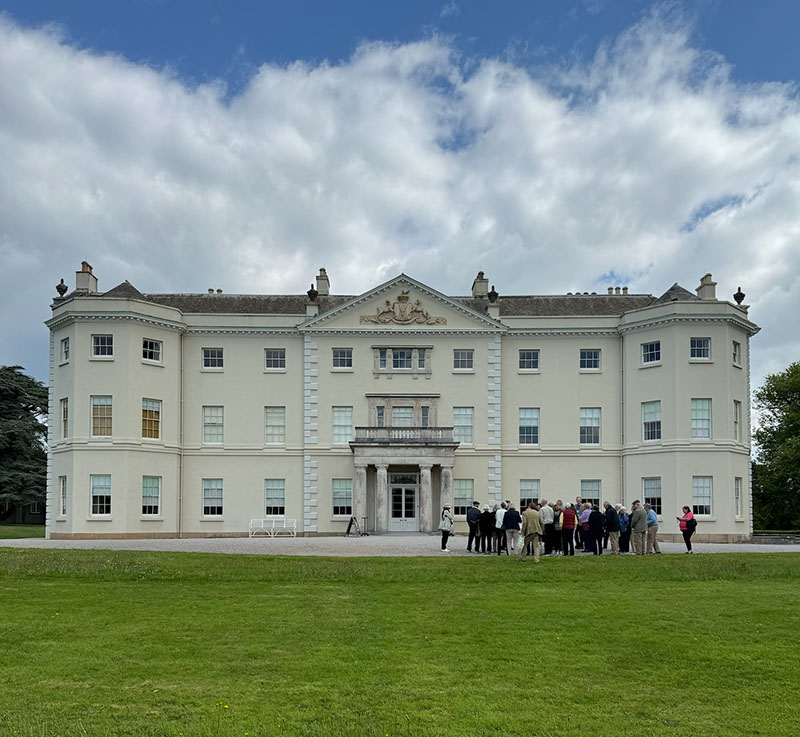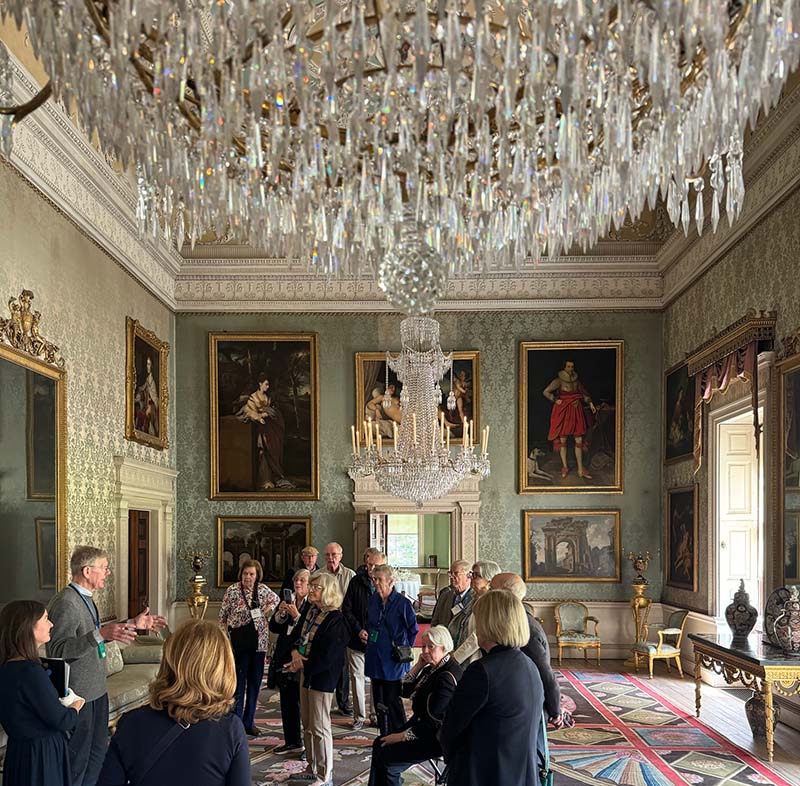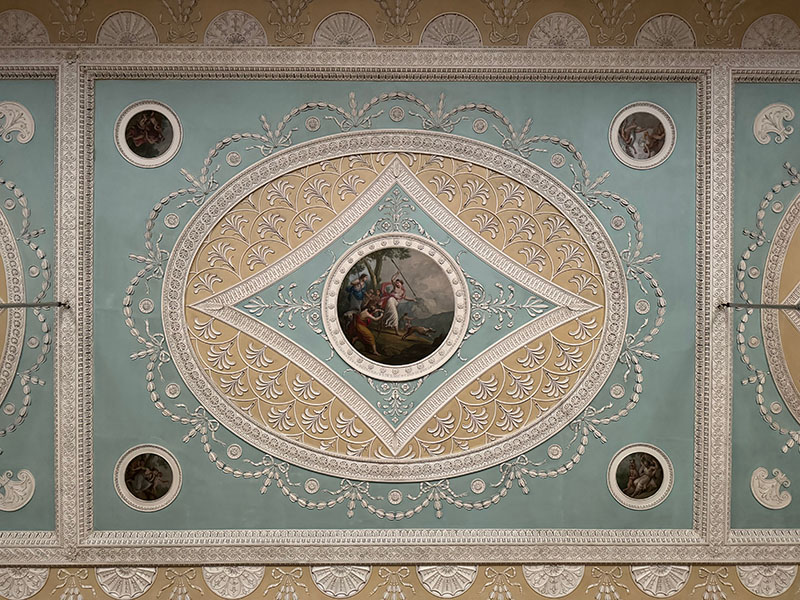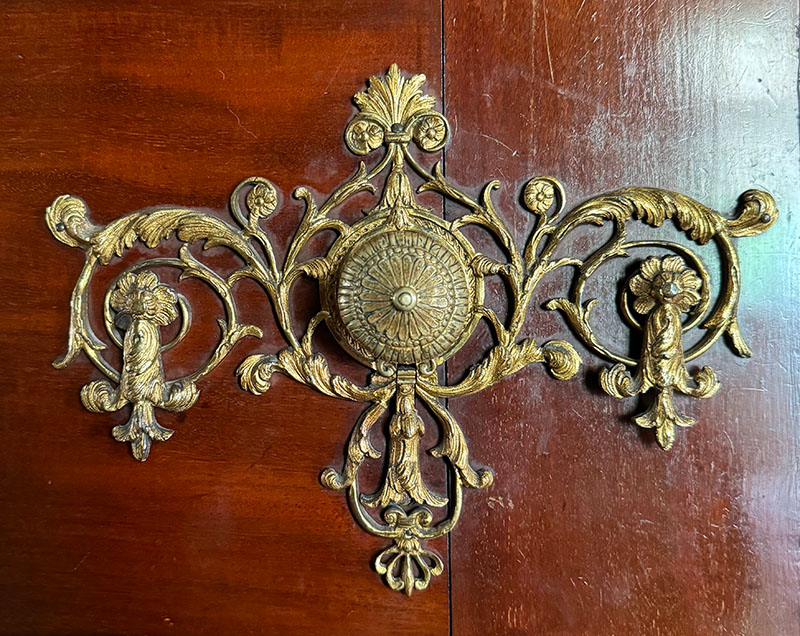Saltram’s Saloon: Adam, Chippendale, and Reynolds in England’s West Country
Click on images to enlarge them and view captions.
England’s West Country is famed for its windswept moors, rolling green hills, and misty secluded beaches connected by a web of narrow country lanes. Although the southwestern reaches of the country are prized for retaining much of their wild and rural appeal, the grand estates that dot the dramatic landscapes reveal a historic pride for popular taste. During our Spring Study Trip Abroad, this came into clear focus at Saltram House, a Tudor-turned-Georgian jewel in Devon now stewarded by the National Trust. In particular, a close look at the Saloon permitted a thorough examination of key objects that attest to this extraordinary house’s standing as a microcosm of refined 18th-century style in the region.
When John Parker the Second, later Lord Boringdon, and his wife, Theresa Robinson, began their occupation of Saltram in 1769, they benefited from an early campaign of changes initiated by the previous generation of Parkers. John Parker the First and Lady Catherine Parker had enhanced the house with a symmetrical Palladian exterior (figure 1), Rococo interiors, and parklands dotted with follies. The Parker family held no title but gradually accumulated wealth over several generations. The union of John and Catherine, who was the daughter of the Earl of Poulett and came from a long aristocratic lineage, elevated the family’s status. Likewise, the marriage of John Parker the Second and Theresa, the daughter of Lord Grantham, helped to raise their standing even further. Theresa viewed Saltram as an opportunity to bring cosmopolitan sensibilities to Devon, and she promoted Robert Adam as the ideal architect to redesign a limited number of rooms in the new Neoclassical taste. The Parkers’ decision to commission Adam, who was on his way to becoming one of the most important architects of the 18th century, gave Saltram and the family social cachet when many of the country gentry in Devon would more typically seek out local builders. Saltram’s Saloon (figure 2) remains a spectacular example of a complete Adam scheme.
A saloon was traditionally the largest and grandest room in the house, a place for the family to hold gatherings and display their finest paintings and furnishings. The expansive Saloon at Saltram stands as an exceptional example of Adam’s design philosophy, featuring abundant allusions to antiquity. Urns, arabesques, leaves, and rosettes are repeated throughout the room in ordered fashion. The plasterwork ornament on the ceiling and walls were carried out by Joseph Rose according to Adam’s delicate and intricate design, set against light blue and yellow paint, giving the room an overall lightness (figure 3). Spaced evenly across the ceiling, Rose incorporated medallions by Venetian painter Antonio Zucchi with a central image of Diana surrounded by roundels of the four seasons.
Corresponding details were repeated elsewhere. From the gilded door handles (figure 4) to the pier glasses, all the fixtures and fittings were designed by Adam. The room also contains a 20-piece set of giltwood seating furniture (figure 5) attributed to Thomas Chippendale, who was likely working with drawings supplied by Adam. The attribution is based on five payments to Chippendale documented in Lord Boringdon’s account book.1
Among the most remarkable elements in the Saloon is the monumental carpet that spans 45 feet in length and more than 19 feet across (see figure 2). The carpet was made for the Parkers in Thomas Whitty’s nearby factory in the Devon market town of Axminster, the modern home for which participants visited during the tours. The local hand-knotted carpets were vibrant, seamless, and became a sensation among 18th-century fashionable elites. Saltram’s carpet was designed by Adam and is among the largest ever produced by Whitty. The color scheme of rose, blue, brown, and green wool was woven to mirror the plasterwork in the ceiling above.
In addition to the remarkable decorative arts, the Saloon also demonstrates the Parkers’ important relationship with Sir Joshua Reynolds. Born in nearby Plympton, Reynolds rose to become one of the most sought-after portrait painters in England. Not only did he paint the majority of the Parker family portraits, but he became a devoted friend and acted as a consultant, acquiring objects and artifacts to be displayed throughout the house. Reynolds, founder and first President of the Royal Academy, was held in very high regard. His 1770–72 portrait of Theresa (see figure 5) in classical dress depicts her in a wooded landscape leaning upon a pedestal topped by a large vase. Her pose in profile, one so often used in funerary imagery, was an uncanny choice, as she died at the age of 30 from complications in childbirth just three years after the portrait was completed. Testifying to their close relationship and mutual respect, Reynolds wrote Theresa’s obituary. Just nine years later, John Parker would be given the title of Baron Boringdon, finally raising the family into the peerage.
Modern viewers can appreciate the Saloon at Saltram as a cross-section of exceptional 18th-century works by English artists and artisans whose reputations and importance has only bloomed over the centuries. Remarkably, this marvel has little changed since the Parkers first embarked upon its transformation in the 1760s. Although the Parker family did not boast a long aristocratic lineage, Saltram and its spectacular Saloon legitimized their elevated status and communicated an acute awareness of fashion and taste.
- Although the individual components of the order are not itemized, the sum of £225 “may not reflect the true scale of the commission.” See Christopher Gilbert, The Life and Work of Thomas Chippendale, London 1972, vol. I, pg. 257.
Catherine Carlisle is the Manager of Educational Programs at the Decorative Arts Trust.
A print version of this article was published in The Magazine of the Decorative Arts Trust, one of our most popular member benefits. Join today!





